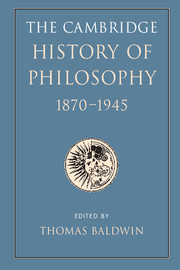Book contents
- Frontmatter
- Contents
- List of contributors
- Introduction
- I 1870–1914
- II 1914–1945
- 8 Logic and philosophy: the analytic programme
- 9 The diversity of philosophy
- 10 Knowledge, language, and the end of metaphysics
- 11 Philosophy and the exact sciences
- 46 First-order logic and its rivals
- 47 The golden age of mathematical logic
- 48 General relativity
- 49 Scientific explanation
- 50 The rise of probabilistic thinking
- 12 Mind and its place in nature
- 13 Philosophy and social science
- 14 Ethics, religion, and the arts
- 15 Law and politics
- Biobibliographical appendix
- Bibliography
- INDEX
- References
46 - First-order logic and its rivals
from 11 - Philosophy and the exact sciences
Published online by Cambridge University Press: 28 March 2008
- Frontmatter
- Contents
- List of contributors
- Introduction
- I 1870–1914
- II 1914–1945
- 8 Logic and philosophy: the analytic programme
- 9 The diversity of philosophy
- 10 Knowledge, language, and the end of metaphysics
- 11 Philosophy and the exact sciences
- 46 First-order logic and its rivals
- 47 The golden age of mathematical logic
- 48 General relativity
- 49 Scientific explanation
- 50 The rise of probabilistic thinking
- 12 Mind and its place in nature
- 13 Philosophy and social science
- 14 Ethics, religion, and the arts
- 15 Law and politics
- Biobibliographical appendix
- Bibliography
- INDEX
- References
Summary
INTRODUCTION
The first-order logic that is commonly taught and used today did not exist at the beginning of the twentieth century. A series of investigations in ‘foundations of mathematics’ by a variety of researchers led to its treatment as the core element of. These investigations searched for a detailed account of how our finite reasoning capacity could lead to knowledge of the infinite quantities involved in mathematics. This issue took on an acute form in the late 1800s when Georg Cantor (1845–1918) showed that mathematics could not be understood without accepting the existence of infinite sets of entities, in particular the complete set of counting (or natural) numbers. He also showed that the existence of such a denumerably infinite set entails the existence of ever larger infinite sets, each having a larger infinite ‘cardinal number’. The methods developed in the studies of mathematical logic were taken over to formulate alternatives to first-order logic. The most important of these were modal logic and intuitionistic logic. This chapter tells the story of these changes.
FIRST-ORDER LOGIC
A first-order logic is a set of logical axioms and formal inference rules for a first-order language. Such a language will contain one-place predicate symbols and multiple-place relation symbols. The language may also have symbols for individual objects and functions. For logical symbols, it typically has the sentential connectives ˜, &, →, ∨, ↔, and the two quantifiers, ∀, ∃. The language is ‘first-order’ because quantifiers apply only to variables which range over the individual objects of the domain. Second-order or higher-order languages have variables that range over sets of objects or of n-tuples drawn from the domain.
- Type
- Chapter
- Information
- The Cambridge History of Philosophy 1870–1945 , pp. 579 - 591Publisher: Cambridge University PressPrint publication year: 2003



